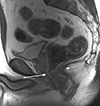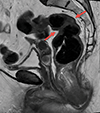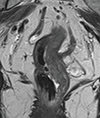The importance of MRI for rectal cancer evaluation
- PMID: 35339339
- PMCID: PMC9464708
- DOI: 10.1016/j.suronc.2022.101739
The importance of MRI for rectal cancer evaluation
Abstract
Magnetic resonance imaging (MRI) has gained increasing importance in the management of rectal cancer over the last two decades. The role of MRI in patients with rectal cancer has expanded beyond the tumor-node-metastasis (TNM) system in both staging and restaging scenarios and has contributed to identifying "high" and "low" risk features that can be used to tailor and personalize patient treatment; for instance, selecting the patients for neoadjuvant chemoradiation (NCRT) before the total mesorectal excision (TME) surgery based on risk of recurrence. Among those features, the status of the circumferential resection margin (CRM), extramural vascular invasion (EMVI), and tumor deposits (TD) have stood out. Moreover, MRI also has played a role in surgical planning, especially when the tumor is located in the low rectum, when the relationship between tumor and the anal canal is important to choose the best surgical approach, and in cases of locally advanced or recurrent tumors invading adjacent pelvic organs that may require more complex surgeries such as pelvic exenteration. As approaches using organ preservation emerge, including transanal local excision and "watch-and-wait", MRI may help in the patient selection for those treatments, follow up, and detection of tumor regrowth. Additionally, potential MRI-based prognostic and predictive biomarkers, such as quantitative and semi-quantitative metrics derived from functional sequences like diffusion-weighted imaging (DWI) and dynamic contrast-enhanced (DCE), and radiomics, are under investigation. This review provides an overview of the current role of MRI in rectal cancer in staging and restaging and highlights the main areas under investigation and future perspectives.
Keywords: Magnetic resonance imaging; Rectal cancer.
Copyright © 2022 Elsevier Ltd. All rights reserved.
Figures



















References
-
- Sung H, Ferlay J, Siegel RL, Laversanne M, Soerjomataram I, Jemal A, Bray F, Global Cancer Statistics 2020: GLOBOCAN Estimates of Incidence and Mortality Worldwide for 36 Cancers in 185 Countries, CA Cancer J Clin 71(3) (2021) 209–249. - PubMed
-
- Brown G, Davies S, Williams GT, Bourne MW, Newcombe RG, Radcliffe AG, Blethyn J, Dallimore NS, Rees BI, Phillips CJ, Maughan TS, Effectiveness of preoperative staging in rectal cancer: digital rectal examination, endoluminal ultrasound or magnetic resonance imaging?, Br J Cancer 91(1) (2004) 23–9. - PMC - PubMed
-
- Akasu T, Kondo H, Moriya Y, Sugihara K, Gotoda T, Fujita S, Muto T, Kakizoe T, Endorectal ultrasonography and treatment of early stage rectal cancer, World J Surg 24(9) (2000) 1061–8. - PubMed
-
- Maizlin ZV, Brown JA, So G, Brown C, Phang TP, Walker ML, Kirby JM, Vora P, Tiwari P, Can CT replace MRI in preoperative assessment of the circumferential resection margin in rectal cancer?, Dis Colon Rectum 53(3) (2010) 308–14. - PubMed
Publication types
MeSH terms
Grants and funding
LinkOut - more resources
Full Text Sources
Research Materials

